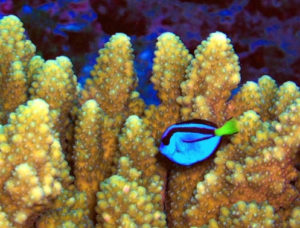Over the past week I’ve been looking into the challenges facing reef fishes and the environments they inhabit, and there are some very clear recurrent themes: overexploitation (on a number of levels), habitat degradation (for a variety of reasons), and climate change. These are all big issues and unfortunately some of them are probably not going away any time soon. My goal here is to give you some general background, so that in future posts we can look at possible solutions and mitigation strategies.

Demand for blue tangs in aquaria was originally satisfied by capturing these fish in the wild, a practice with big repercussions for the wild populations. Photo by J Maragos and courtesy of USFWS.
Overexploitation of reef fish comes from both the food trade and the aquarium trade, so there are several different pressures on fish populations and fishing methods involved. In addition to the use of nets (which can damage coral they get caught on- Öhman et al. 1993), fishermen also use explosives in some areas to kill fish and cyanide is used to stun fish for capture and sale in the aquarium trade (Hinrichsen 1997). Although we might think of the aquarium trade as being as a fairly stable industry in which fish are raised for sale, as of 2001 less than 1 % of marine fish in the aquarium trade were farmed (Wood 2001), so the public demand for colorful reef fish to own can have a big impact on wild stocks. Foster & Vincent (2005) suggested that there be a minimum size limit for seahorses collected from wild stocks to ensure that fish could mature and reproduce (thus contributing to future generations) before going into someone’s aquarium or traditional medicine. And there can be collateral damage to non-target species as well- fishermen catching Banggai cardinalfish in Indonesia use sea urchins to lure the fish into traps, sometimes harming the urchin in the process (Kolm and Berglund 2003). The same study also found that fished areas had smaller groups of cardinalfish (which seem to have a group-homing instinct) and this could make them more vulnerable to predation.
Even when the reef fish populations aren’t being directly exploited, they oftentimes face habitats that are reduced versions of what they once were. In addition to collecting corals for the aquarium trade, some coral reefs are mined for building materials and lime production (Berg et al. 1998). Since corals are accreted slowly over time, coral mining tends to remove coral formations faster than they can develop. Sedimentation of reefs is another issue- as run-off from land (because of land clearing, increased erosion, etc.) deposits mud and other particles on reefs, it can smother the corals (Rajasuriya et al. 1995). Pollution also degrades reef systems [and sometimes it’s a type of pollution we might not be expecting- underwater testing of explosives, such as those carried out on Mururoa Atoll between 1976 and 1995, creates huge changes in water pressure and fish with swim bladders can’t survive the changes if they are too close to the blast zone (Planes et al. 2005)].
Climate change adds another layer of stress to these reef systems, and it comes on two fronts. One of the issues is the rising temperature of the water- the corals that we find in reefs are often working in symbiosis with dinoflagellates which provide most of the energy the corals use, but these relationships can be undone by rising temperatures and this results in coral ‘bleaching’ (Hoegh-Guldberg et al. 2007). In addition to rising temperatures, climate change features an increasingly acidic ocean as more and more carbon dioxide is absorbed- this is a very big problem for corals because they use carbonate to create their hard structures, and carbonate becomes scarce in acidic waters. As a result, we could see no or even negative coral growth once the oceans hit a certain level of acidity.
So there are some very big challenges facing reef fishes and the coral reefs they inhabit- some of this is directly related to our oceanic activities and some of it comes from larger issues of climate change. Plus we have the decisions people make about what to have in their aquaria. Do we have options for helping coral meet some of these challenges? That’s what I’ll search for in my next post.
Works cited:
Berg, H., M.C. Öhman, S. Troëng, and O. Lindén. 1998. Environmental Economics of Coral Reef Destruction in Sri Lanka. Ambio 27:627–634.
Foster, S.J., and A.C.J. Vincent. 2005. Enhancing Sustainability of the International Trade in Seahorses with a Single Minimum Size Limit. Conservation Biology 19:1044–1050.
Hinrichsen, D. 1997. Coral Reefs in Crisis. BioScience 47:554–558.
Hoegh-Guldberg, O., P.J. Mumby, A.J. Hooten, R.S. Steneck, P. Greenfield, E. Gomez, C.D. Harvell, P.F. Sale, A.J. Edwards, K. Caldeira, N. Knowlton, C.M. Eakin, R. Iglesias-Prieto, N. Muthiga, R.H. Bradbury, A. Dubi, and M.E. Hatziolos. 2007. Coral Reefs under Rapid Climate Change and Ocean Acidification. Science 318:1737–1742.
Kolm, N., and A. Berglund. 2003. Wild Populations of a Reef Fish Suffer from the “Nondestructive” Aquarium Trade Fishery. Conservation Biology 17:910–914.
Öhman, M.C., A. Rajasuriya, and O. Lindén. 1993. Human Disturbances on Coral Reefs in Sri Lanka: A Case Study. Ambio 22:474–480.
Planes, S., R. Galzin, J.-P. Bablet, and P.F. Sale. 2005. Stability of Coral Reef Fish Assemblages Impacted by Nuclear Tests. Ecology 86:2578–2585.
Rajasuriya, A., M.W.R.N.D. Silva, and M.C. Öhman. 1995. Coral Reefs of Sri Lanka: Human Disturbance and Management Issues. Ambio 24:428–437.
Wood, E. 2001. Collection of coral reef fish for aquaria: global trade, conservation issues and management strategies. Marine Conservation Society, UK. Available online at http://agris.fao.org/agris-search/search.do?recordID=GB2013200400. Accessed September 8, 2016.
